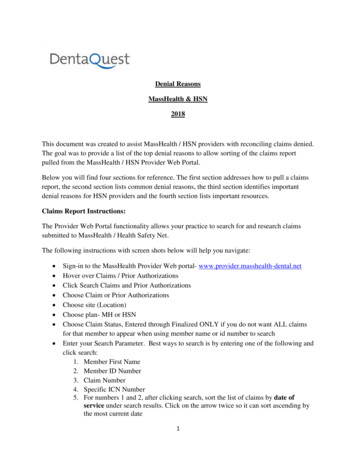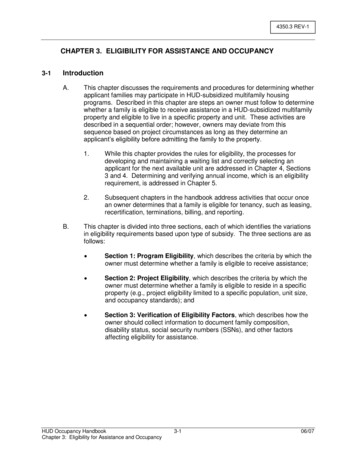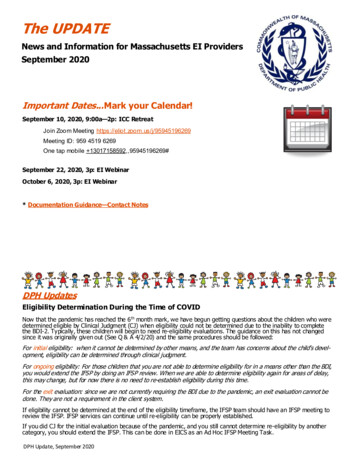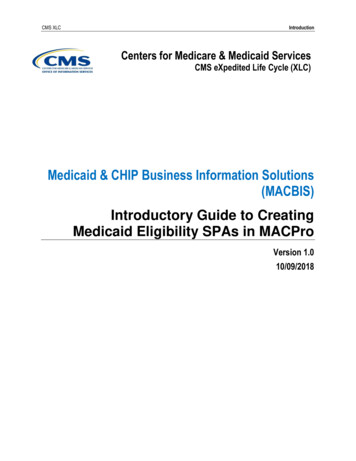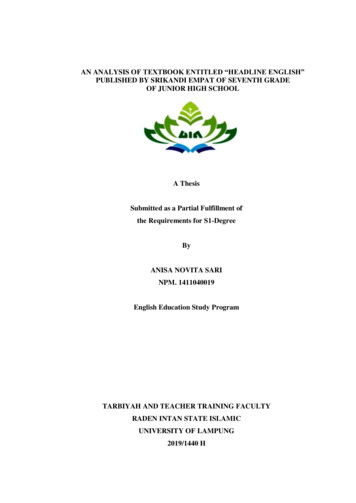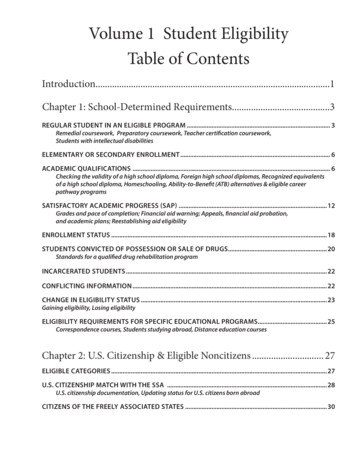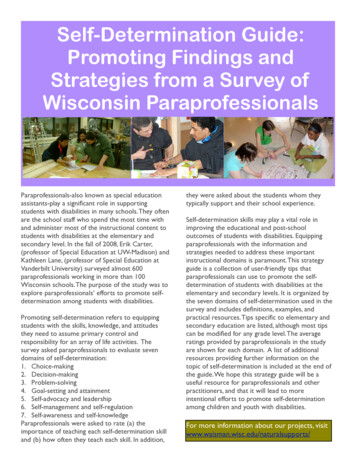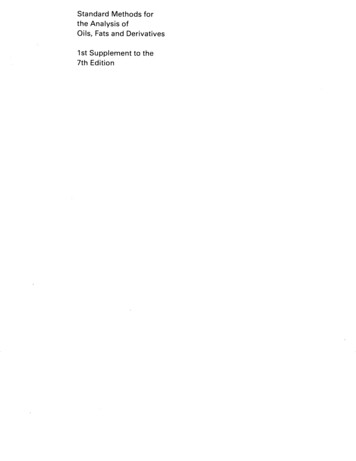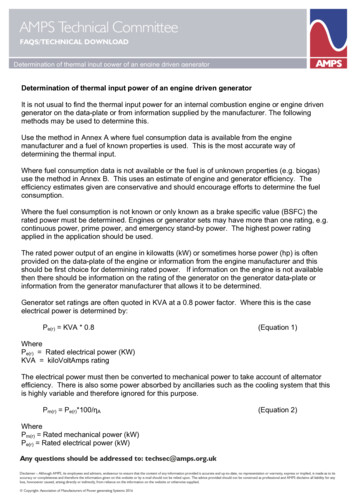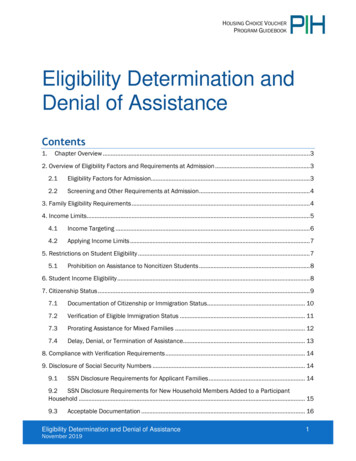
Transcription
HOUSING CHOICE VOUCHERPROGRAM GUIDEBOOKEligibility Determination andDenial of AssistanceContents1.Chapter Overview . 32. Overview of Eligibility Factors and Requirements at Admission . 32.1Eligibility Factors for Admission. 32.2Screening and Other Requirements at Admission . 43. Family Eligibility Requirements . 44. Income Limits. 54.1Income Targeting . 64.2Applying Income Limits . 75. Restrictions on Student Eligibility . 75.1Prohibition on Assistance to Noncitizen Students . 86. Student Income Eligibility . 87. Citizenship Status . 97.1Documentation of Citizenship or Immigration Status . 107.2Verification of Eligible Immigration Status . 117.3Prorating Assistance for Mixed Families . 127.4Delay, Denial, or Termination of Assistance. 138. Compliance with Verification Requirements . 149. Disclosure of Social Security Numbers . 149.1SSN Disclosure Requirements for Applicant Families . 149.2SSN Disclosure Requirements for New Household Members Added to a ParticipantHousehold . 159.3Acceptable Documentation . 16Eligibility Determination and Denial of AssistanceNovember 20191
HOUSING CHOICE VOUCHERPROGRAM GUIDEBOOK10. Background Screening . 1610.1 Criminal Background Screening. 1610.2 Additional PHA Discretionary Admission Criteria . 1811. EIV System Searches at Admission . 1911.1 Existing Tenant Search and Avoiding Duplicate Subsidy. 1911.2 HUD-52675 Debts Owed to PHAs and Terminations. 2011.3 120-day review of Income Report . 2012. Notifications to Family . 2012.1 Emergency Contact . 2012.2 Notification Requirements. 2012.3 Effective Communication and Limited English Proficiency Requirements . 2113. Denial of Assistance . 2113.1 Timing of Denial . 2113.2 Non-discrimination . 2113.3 Consideration of Circumstances . 2214. Chapter Glossary . 23Exhibit 1:Non-citizen Rule – Summary of Documentation Requirements . 24Changes from previous versionPage3Description of ChangeText under the “Student status” subheading changed from “Thehousehold must meet additional eligibility criteria if the head, cohead, or spouse is a full-time student or a non-citizen student.”Changed to “Students of higher education that do not live withtheir parents must meet additional eligibility criteria.”Date Change MadeNovember 20196Capitalized “OR” under Income Limits to highlight that the familymust be very low income OR low income and meet one of thecriteria listed below.November 20197Corrected text changing “time as admission” to “time ofadmission”November 201912Moved “Compliance with Verification Requirements” to section 8.November 201919Removed from the list of additional PHA discretionary admissioncriteria: “If a family participating in the FSS program fails tocomply, without good cause, with the family’s FSS contract ofparticipation.”November 2019Eligibility Determination and Denial of AssistanceNovember 20192
HOUSING CHOICE VOUCHERPROGRAM GUIDEBOOK1. Chapter OverviewThis chapter outlines the U.S. Department of Housing and Urban Development’s (HUD) eligibility requirementsfor participation in the Housing Choice Voucher (HCV) program and provides guidance to Public HousingAuthorities (PHAs) in establishing additional criteria for admission. PHAs should strive for objectivity andconsistency when applying these criteria to evaluate the eligibility of families who apply for assistance. PHAsmust1 provide families applying for assistance the opportunity to explain their circumstances, furnishadditional information if required, and receive an explanation of the basis for any decision regarding theireligibility.As with all areas of program administration, when determining family eligibility PHAs must2 comply with allFederal, State, and local nondiscrimination laws, and with rules and regulations governing fair housing andequal opportunity in housing and employment. See the Fair Housing Requirements chapter for moreinformation.2. Overview of Eligibility Factors and Requirements atAdmissionThere are four factors that PHAs must3 consider when determining eligibility for the HCV program. In additionto the eligibility factors, there are screenings that the PHA must4 conduct that may result in denial ofassistance. Each factor is summarized below and then discussed further in a corresponding subsection.Before denying assistance for any criteria, the PHA should review Section 12, Denial of Assistance, to ensurecompliance with the Violence Against Women Act (VAWA) and other nondiscrimination requirements.2.1Eligibility Factors for AdmissionFamily eligibility requirements: The household must5 meet HUD’s definition of a “family”. HUD’s definition of“family” is provided in Section 3, Family Eligibility Requirements.Income limits: The household's annual income must6 not exceed the applicable income limit as established byHUD in the jurisdiction where the family leases a unit. This requirement only applies at the time of admissionand is further described in Section 4, Income Limits.Student status: Students of higher education that do not live with their parents must7 meet additionaleligibility criteria. Detailed requirements are explained in Section 5, Restrictions on Student Eligibility.Citizenship status: The applicant family must8 have eligible immigration status with supportingdocumentation. Citizenship status only needs to be verified once at the time of admission for each household123456782424242424242424CFR § 982.554CFR § 1.4; 982.552(c)(2); 982.202(b)(3); 5.105(a)CFR § 982.201CFR § 5.216; § 5.905; § 5.903CFR § 982.201(a)CFR § 982.201(b)CFR § 5.612; 5.522CFR § 982.201(a)Eligibility Determination and Denial of AssistanceNovember 20193
HOUSING CHOICE VOUCHERPROGRAM GUIDEBOOKmember. Information on how to verify citizenship and immigration status and calculate assistance for familiesthat include ineligible noncitizens is provided in Section 7, Citizenship Status.2.2Screening and Other Requirements at AdmissionDisclosure of Social Security Numbers and compliance with verification requirements. The household must9sign consent forms and provide requested verification materials to allow the PHA to verify the household’sinformation. The applicant must10 also disclose and document the SSNs of all family members (with a fewexceptions described in Section 8, Disclosure of Social Security Numbers). SSNs only need to be verified onceper household member.Background screening. The PHA must11 conduct background screenings to ensure no member of thehousehold is subject to a lifetime sex offender registration requirement. All adult household members must12sign a criminal background consent form to authorize the PHA to conduct background screenings. PHAs mayestablish additional nondiscriminatory criteria for admission. If the PHA chooses to establish additionalcriteria, the standards must13 be applied consistently and be listed in the PHAs’ administrative plan. Detailson which other types of activity may result in denial of assistance and the PHAs options for setting additionalcriteria are discussed in Section 9, Background Screening.Enterprise Income Verification (EIV) system searches. PHAs must11 use HUD’s EIV system to search for allhousehold members using the Existing Tenant Search and all adult household members in the Search forFormer Tenant. All adult household members must also sign the HUD-52675. The PHA may be required todeny assistance to household members who are already receiving assistance from another program or whoowe an outstanding debt to another PHA. More information on the required searches and interpreting theresults is provided in Section 10, EIV Searches at Admission.3. Family Eligibility RequirementsEach applicant for assistance under the HCV program must14 meet HUD’s definition of family. A familyincludes15, but is not limited to, regardless of marital status, actual or perceived sexual orientation, or genderidentity, the following:1) A single person, who may be an elderly person, displaced person, disabled person, near-elderly person, orany other single person;2) A group of persons residing together, and such group includes, but is not limited to:a) A family with or without children. A child temporarily absent from the home due to placement in fostercare must16 be considered in determining family composition and size. A family that consists of apregnant woman only, and no other persons, must17 be treated as a two-person family.924 CFR § 5.230; § 982.551(b); § 5.23324 CFR § 5.216(h)(1); 24 CFR § 982.551(b)(3)1124 CFR § 5.905(a)(1)1224 CFR § 5.903(b)(1)1324 CFR § 982.54(d)(4)(i)1424 CFR § 5.233; PIH Notice 2018-18 Administrative Guidance for Effective and Mandated Use of the EnterpriseIncome Verification (EIV) System, pg. 31524 CFR § 5.403; 42 USC 1437a(b)(3)1624 CFR § 5.403 Family(2)(i)1724 CFR § 982.402(b)(5)10Eligibility Determination and Denial of AssistanceNovember 20194
HOUSING CHOICE VOUCHERPROGRAM GUIDEBOOKb) An elderly family, which is defined as a family whose head, co-head, spouse, or sole member is at least62 years of age. It may include two or more persons, each of whom are at least 62, living together; orone or more persons who are at least 62 living with one or more live-in aides.c) A near-elderly family, which is defined as a family whose head, co-head, spouse, or sole member is atleast 50 years of age but below the age of 62; or two or more persons, each of whom are between theages of 50 and 62, living together; or one or more persons who are between the ages of 50 and 62living with one or more live-in aides.d) A disabled family, which means a family whose head, co-head, spouse, or sole member, is a personwith disabilities; or two or more persons with disabilities living together; or one or more persons withdisabilities living with one or more live-in aides.i) A person with disabilities means a person who:(1) Has a disability as defined in 42 U.S.C. § 423(d)(1);(2) Has a physical, mental or emotional impairment that is expected to be of long-continued andindefinite duration, substantially impedes his or her ability to live independently, and is of sucha nature that ability to live independently could be improved by more suitable housingconditions; or(3) Has a developmental disability as defined in 42 U.S.C. § 15002(8) (formerly codified in 42U.S.C. § 6001).ii) Important considerations:(1) The meaning of a person with disabilities does not exclude persons who have the disease ofacquired immunodeficiency syndrome (AIDS) or any conditions arising from the etiologic agentfor AIDS.(2) The meaning of a person with disabilities does not include a person whose disability is basedsolely on any drug or alcohol dependence (for eligibility purposes).(3) A person who qualifies as a person with disabilities also qualifies as an individual withhandicaps, as defined in 24 C.F.R. § 8.3, for purposes of reasonable accommodation andprogram accessibility for persons with disabilities.(4) The terms disability and a person with disabilities are used in two contexts – for civil rightsprotections, and for program eligibility purposes. Each use has specific definitions.(a) When used in context of protection from discrimination or improving the accessibility ofhousing, the civil rights-related definitions apply (see 24 CFR § 8.3; 24 CFR § 100.201; 28CFR §§ 35.104,108).(b) When used in the context of eligibility under the HCV program, the program eligibilitydefinitions applye) A displaced family, which is a family in which each member or the sole member is a person displacedby governmental action, or whose dwelling has been extensively damaged or destroyed as a result of adisaster declared or otherwise formally recognized under Federal disaster relief laws.f) A remaining member of a tenant family, which is a family member of an assisted tenant family whoremains in the unit when other members of the family have left the unit.4. Income LimitsHUD establishes income limits by family size for the area in which each PHA is located. These income limitsare used to determine the family’s eligibility for the program and are published annually in a HUD Notice andare generally effective on the date of publication. The income limits are available on HUD USER website.Eligibility Determination and Denial of AssistanceNovember 20195
HOUSING CHOICE VOUCHERPROGRAM GUIDEBOOKTo be eligible for the program, a family must18 be either very low income (generally 50% of area medianincome); OR low-income (generally 80% of area median income) and meet one of the following additionalcriteria: Continuously assisted under the public housing, housing choice voucher, project-based rentalassistance, or other housing program under the Housing Act of 1937. Non-purchasing households inthe following homeownership programs: HOPE 1, HOPE 2, or other HUD-assisted multifamily homeownership programs covered under 24 CFR § 284.173; Displaced as a result of the prepayment of a mortgage or voluntary termination of a mortgageinsurance contract on “eligible low-income housing,” as defined in 24 CFR § 248.101. Note thatthese displaced families are also eligible if they have moderate income (between 80 and 95 percentof median area income). A criterion set by the PHA to address essential local housing needs. For example, a PHA mayadminister its HCV program in a jurisdiction that offers locally-funded assisted housing to low-incomefamilies. The PHA may include a policy in its administrative plan stating the low-income limit will beapplied when determining income eligibility for families transitioning from locally-funded assistedhousing.4.1Income TargetingEach PHA must19 ensure that 75 percent of its admissions in each PHA fiscal year are families whose incomesare at or below the extremely low-income (ELI) limit (see definition below).20 Less than 75 percent of ELIpermitted with HUD approval, in accordance with PHA Plan and additional circumstances described in982.201(b)(2)(ii)(A)-(D). The Waiting List and Tenant Selection chapter contains rules pertaining to “targeting”of assistance to extremely low-income families.Definition of Extremely Low IncomeExtremely low-income refers to families whose incomes meet the very lowincome threshold (50% of area median income) and do not exceed the higherof the federal poverty line or 30% of area median income. This definitionbecame effective on July 1, 2014, ensuring working families living in areaswhere the federal poverty line exceeds 30% of area median income will meetthe ELI income targeting requirements.PHAs do not need to determine the ELI limit for their local area. HUD publishesthe ELI limits annually on HUD USER.1824 CFR § 982.201(b)(1)24 CFR § 982.201(b)(2)2024 CFR § 5.603; Federal Register Notice 79 FR 35940, HUD Implementation of Fiscal Year 2014 AppropriationsProvisions on Public Housing Agency Consortia, Biennial Inspections, Extremely Low-Income Definition and UtilityAllowances, July 1, 2014.19Eligibility Determination and Denial of AssistanceNovember 20196
HOUSING CHOICE VOUCHERPROGRAM GUIDEBOOK4.2Applying Income LimitsAnnual Income is compared to the applicable income limit to determine eligibility. A family’s income must21 bewithin the income limits for the PHA’s jurisdiction at the time the family receives a voucher to search forhousing. In addition, the family, when it is first admitted, must select a unit in an area in which the familymeets the income limit for the housing choice voucher program. Income limits apply only at the time ofadmission and are not a factor in ongoing program eligibility.A PHA with more than one set of income limits within its jurisdiction must22 use the highest income limit withinits jurisdiction when determining initial household eligibility. However, a family whose income is above thelimits in one or more areas of that PHA’s jurisdiction may lease only in an area where the family is incomeeligible when it executes its first lease assisted under the voucher program. Similarly, a family exercisingportability when first admitted to the program must lease in an area where it is within the eligibility incomelimit.To determine which applicants qualify as continuously assisted, the PHA must23 establish policies concerningwhether and to what extent a brief interruption between assistance under one of these programs andadmission to the voucher program will be considered to break continuity of assistance under the 1937Housing Act.5. Restrictions on Student EligibilityStudents at institutions of higher education who will not reside with their parents must24 meet additionaleligibility criteria. These rules apply regardless of whether the student is considered a full-time or a part-timestudent.Assistance shall only be provided to students who are otherwise eligible for the program and meet at least oneof the following criteria. The student: Is 24 years of age or older; Is a veteran; Is married; Has a dependent child; Is a person with disabilities (as defined in Section 3 of this Chapter) who was receiving HCV assistanceas of November 30, 2005; or Is a graduate or professional student; or Is individually income eligible and the student’s parents are individually or jointly income eligible; or Is an independent student, defined as:a) The individual is 24 years of age or older by December 31 of the award year;2124 CFR § 982.201(d)24 CFR § 982.201(b)(4)2324 CFR § 982.201(d)(2)2424 CFR § 5.612; Eligibility of Independent Students for Assisted Housing Under Section 8 of the U.S. HousingAct of 1937; Supplementary Guidance (71 FR 18145, April 10, 2006); Eligibility of Independent Students forAssisted Housing Under Section 8 of the U.S. Housing Act of 1937; Additional Supplementary Guidance (FR 5969N-01, September 21, 2016)22Eligibility Determination and Denial of AssistanceNovember 20197
HOUSING CHOICE VOUCHERPROGRAM GUIDEBOOKb) The individual is an orphan, in foster care, or a ward of the court or was an orphan, in fostercare or a ward of the court at any time when the individual was 13 years of age or older;c) The individual is, or was immediately prior to attaining the age of majority, an emancipatedminor or in legal guardianship as determined by a court of competent jurisdiction in theindividual's state of legal residence. Or, is classified as a Vulnerable Youth. A student meets HUD's definition of Vulnerable Youth when theindividual has been verified during the school year in which the application is submitted as either an“unaccompanied youth” who also falls within the definition of “homeless children and youths” (assuch terms are defined in Section 725 of the McKinney-Vento Homeless Assistance Act), or asunaccompanied youth (as defined in Section 725 of the McKinney-Vento Homeless Assistance Act),who are at risk of homelessness and self-supporting, by:a) A local educational agency homeless liaison, designated pursuant to the McKinney-VentoHomeless Assistance Act;b) The director of a program funded under the Runaway and Homeless Youth Act or designee ofthe director;c) The director of a program funded under subtitle B of title IV of the McKinney-Vento HomelessAssistance Act or a designee of the director ord) A financial aid administrator. Or, the individual is a student for whom a financial aid administrator makes a documenteddetermination of independence by reason of other unusual circumstances.For purposes of the student eligibility restrictions, the term “parents” means the biological or adoptiveparents, or guardians (e.g., stepparents, grandparents, aunt/uncle, godparents, etc.), or such other definitionas may be adopted in the PHA’s administrative plan.5.1Prohibition on Assistance to Noncitizen StudentsNoncitizen students, even those with eligible immigration status for purposes of HUD’s financial assistance,are not eligible to receive housing assistance.25A noncitizen student is a bona fide student who: Is pursuing a course of study in this country; Has a residence in another country outside of the United States that the person has no intention ofabandoning; and Is admitted to this country temporarily, solely for the purpose of studying.When a noncitizen student is accompanied by a noncitizen spouse and/or noncitizen minor children, thosefamily members are also ineligible for assistance. If the noncitizen student and noncitizen spouse have citizenchildren, the whole family is still ineligible for assistance. However, if a non-citizen student has a citizenspouse, the citizen spouse and children if any, would be eligible for assistance. In that case, assistance wouldbe prorated to ensure that assistance goes only to those family members with eligible immigration status.6. Student Income EligibilityIf an individual is enrolled as a student at an institution of higher education, is under the age of 24, not aveteran, not married, is not a person with disabilities who was receiving assistance on November 30, 2005,and does not have a dependent child, in order to be eligible for assistance, the student must be individually2524 CFR 5.522; 42 USC 1436a(c)(2)(A)Eligibility Determination and Denial of AssistanceNovember 20198
HOUSING CHOICE VOUCHERPROGRAM GUIDEBOOKeligible to receive assistance and the student’s parents (the parents individually or jointly) must be incomeeligible to receive assistance unless the student can demonstrate his or her independence from parents withthe guidance in the Supplementary Guidance Notice published in the April 10, 2006 Federal Register (71 FRPHA Options: Verification of Parent Income EligibilityThe PHA may establish its own procedure for verifying parental income eligibility. For example,PHAs could require a signed income certification from the parents with a penalty of perjurystatement, or the PHA may also choose to request supporting documentation of parental incomesuch as tax returns, award letters, or paystubs.PHAs may adopt and implement the following criteria for determining whether to obtain thedeclaration and certification of income from parents, individually or jointly. If the student’s parents are married and living with each other, obtain the declaration andcertification of income from each parent. If the student’s parent is widowed or single, obtain the declaration and certification ofincome from that parent. If the student’s parents are divorced or separated, obtain the declaration and certificationof income from each parent.If the student has been living with one of his or her parents and has not had contact with or doesnot know where to contact his or her other parent, obtain from the student a certification underpenalty of perjury, addressing the circumstances (including a statement that the student has notreceived financial assistance from the parent) and obtain from the parent whom the student hasbeen living or has contact with the declaration and certification of income.7. Citizenship StatusEligibility for Federal housing assistance is limited26 to U.S. citizens and noncitizens who have eligibleimmigration status. Families in which all members are U.S. citizens or have eligible immigration status areeligible for housing assistance.27 Families in which at least one member is a U.S. citizen or has eligibleimmigration status may also be eligible for pro-rated assistance. A family in which some family members haveeligible immigration status, and some do not contend eligible immigration status, is called a mixed family.Mixed families receive prorated assistance based on the percentage of family members who qualify forassistance.28An individual who is not a U.S. citizen or national who is a resident of the U.S. and has any of the followingimmigration statuses is eligible for assistance:29 A non-citizen lawfully admitted for permanent residence as an immigrant (includes special agriculturalworkers granted lawful temporary resident status and noncitizens that indicate they have satisfactoryimmigration status, such as VAWA self-petitioners, whose verification of eligibility or appeal of adetermination as to permanent residence is pending with DHS). A non-citizen who entered the United States before 1/1/72 (or such later date as enacted by law) and:2627282924 CFR § 5.506(a)24 CFR § 5.506(b)24 CFR § 5.516(b)Section 214 of the Housing and Community Development Act of 1980, as amended (42 U.S.C. 1436a(a))Eligibility Determination and Denial of AssistanceNovember 20199
HOUSING CHOICE VOUCHERPROGRAM GUIDEBOOKHas continuously maintained residence in the U.S. since then; andIs not ineligible for citizenship, but who is deemed to be lawfully admitted for permanentresidence as a result of an exercise of discretion by the Attorney General.A non-citizen who is lawfully present in the United States as a result of:o Refugee status, including:1) Those granted Temporary Protective Status (TPS) under the Victims of Trafficking andViolence Protection Act of 2000 (P.L. 106-386) (section 207 of the Immigration andNationality Act (INA)) – these families have a “T” visa; or2) The granting of asylum (which has not been terminated (section 208); or3) The granting of conditional entry (section 203 (a)(7)) prior to 4/1/80 because ofpersecution of fear on account of race, religion, or political opinion, or because ofbeing uprooted by catastrophic national calamity.A non-citizen who is lawfully present in the United States as a result of an exercise of discretion by theAttorney General for emergent reasons or reasons deemed strictly in the public interest (section221(d)(5)) (e.g., parole status).A non-citizen who is lawfully present in the United States as a result of the Attorney General's’withholding deportation (section 243(h)) (threat to life or freedom).A non-citizen lawfully admitted for temporary or permanent residence (245A) (amnesty granted).An alien who is lawfully residing in the United States and its territories and possessions under section141 of the Compacts of Free Association between the Government of the United States and theGovernments of the Marshall Islands, the Federated States of Micronesia (48 U.S.C. 1901 note) andPalau (48 U.S.C. 1931 note) while the applicable section is in effect: Provided, That, within Guam anysuch alien shall not be entitled to a preference in receiving assistance under this Act over any UnitedStates citizen or national resident therein who is otherwise eligible for such assistance.oo 7.1Documentation of Citizenship or Immigration StatusEach eligible household member (or the parent/guardian for household
OUSING Eligibility Determination and Denial of Assistance 5 November 2019 H CHOICE VOUCHER PROGRAM GUIDEBOOK b) An elderly family, which is defined as a family whose head, co-head, spouse, or sole member is at least

